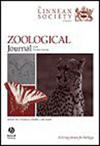Genetic diversity, phylogeography, and sexual dimorphism in the extinct giant short-faced bear (Arctodus simus)
IF 2.8
2区 生物学
Q1 ZOOLOGY
引用次数: 0
Abstract
Giant short-faced bears (Arctodus simus) were the largest carnivoran of Pleistocene North America and are one of the most extensively studied extinct megafaunal species from the continent. Smaller and larger forms of A. simus have previously been recognized and are sometimes considered subspecies (A. s. simus and A. s. yukonensis, respectively). However, researchers have also proposed that this size variation is primarily the result of sexual dimorphism. We sequenced 31 mitogenomes of A. simus from locations ranging from Alaska to New Mexico. Our results revealed a lack of phylogeographic structure in A. simus, as well as low genetic diversity and relatively recent mitochondrial diversification. These observations may either represent population bottlenecks during the Late Pleistocene or simply a naturally low effective population size resulting from a dispersed population and low population density. We found no evidence for genetic differences among our samples, which were compatible with the previously proposed A. simus subspecies. In contrast, all large specimens to which we could assign a sex using genetic data were male, whereas the small specimens in our dataset were all female, supporting the hypothesis that A. simus size variation can be explained by sexual dimorphism.已灭绝的巨型短面熊(Arctodus simus)的遗传多样性、系统地理学和两性二态性
巨型短面熊(Arctodus simus)是北美更新世最大的食肉动物,也是该大陆研究最广泛的灭绝巨型动物之一。较小和较大形式的simus先前已被识别,有时被认为是亚种(分别为a.s. simus和a.s. yukonensis)。然而,研究人员也提出,这种大小变化主要是两性二态性的结果。我们对从阿拉斯加到新墨西哥州的31种猿猴的有丝分裂基因组进行了测序。我们的研究结果表明,猕猴缺乏系统地理结构,遗传多样性低,线粒体多样化相对较晚。这些观察结果可能代表了晚更新世时期的种群瓶颈,或者仅仅是由于种群分散和种群密度低而导致的自然的低有效种群规模。我们没有发现样本之间存在遗传差异的证据,这与之前提出的A. simus亚种兼容。相比之下,我们可以用遗传数据确定性别的所有大样本都是雄性,而我们数据集中的小样本都是雌性,这支持了a . simus大小变化可以用性别二态性来解释的假设。
本文章由计算机程序翻译,如有差异,请以英文原文为准。
求助全文
约1分钟内获得全文
求助全文
来源期刊
CiteScore
6.50
自引率
10.70%
发文量
116
审稿时长
6-12 weeks
期刊介绍:
The Zoological Journal of the Linnean Society publishes papers on systematic and evolutionary zoology and comparative, functional and other studies where relevant to these areas. Studies of extinct as well as living animals are included. Reviews are also published; these may be invited by the Editorial Board, but uninvited reviews may also be considered. The Zoological Journal also has a wide circulation amongst zoologists and although narrowly specialized papers are not excluded, potential authors should bear that readership in mind.

 求助内容:
求助内容: 应助结果提醒方式:
应助结果提醒方式:


